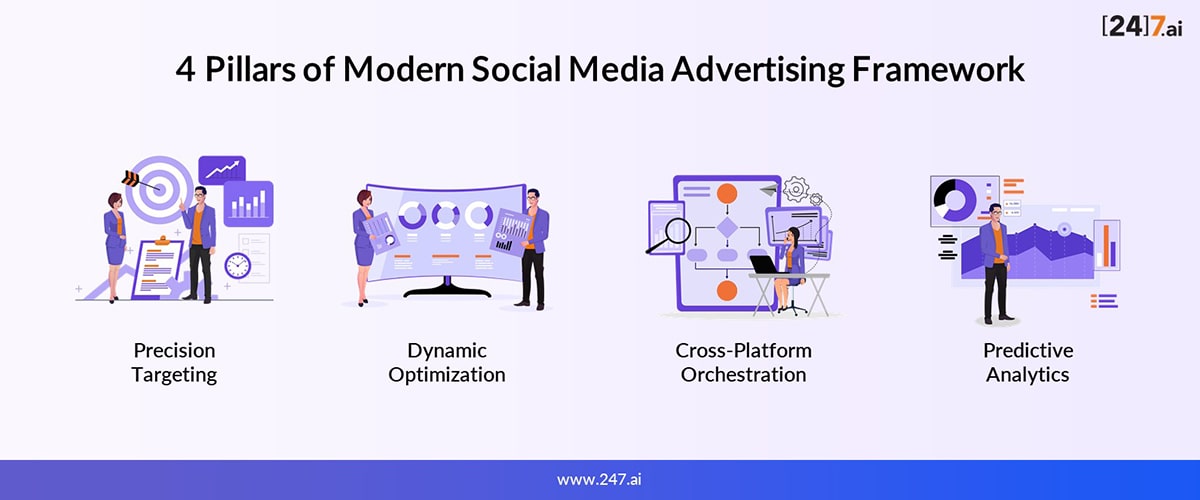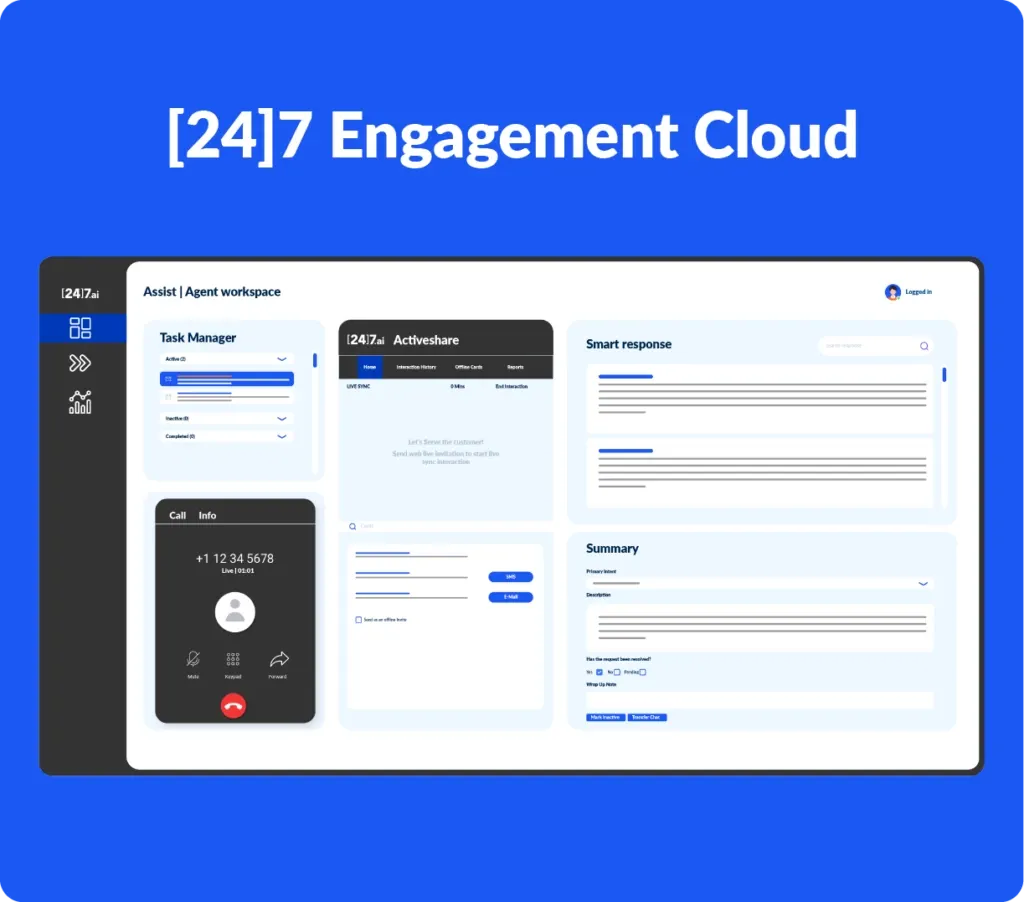Table of contents
- Introduction
- The ROI Paradox & Strategic Inflection Point
- The Modern Framework: Four Pillars of Excellence
- Platform-Specific Strategic Considerations
- The True Cost of Social Media Advertising: Beyond CPM to Customer Lifetime Value
- Achieve Campaign Excellence: Strategic Case Studies & Tactical Execution
- AI-Powered Campaign Management: The Competitive Advantage Implementation Roadmap for Organizations
- Strategic Recommendations: Building Sustainable Competitive Advantage
- The Future of Social Media Advertising Excellence – [24]7.ai
- FAQs
Social media advertising has transitioned from a merely brand-building channel to a vital driving force for measurable business results. As social media platforms continue to innovate, businesses must move forward. Specifically, businesses must get out of the mindset that social media advertising is a cost center and embrace the reality that social media advertising can (and should) be a revenue engine. With the global market set to exceed $262 billion by 2028, brands are facing increased competition and acquisition costs, as well as higher pressure to develop ROI. After all, we live in an age of limited attention and resources. Therefore, strategic clarity and precision required in execution have never been more important.
This blog post explores the evolving definition, cost structures, and real-world campaign examples of social media advertising. Most importantly, it examines how businesses can leverage these insights to drive scalable growth and long-term impact.

The ROI Paradox & Strategic Inflection Point
Even with increased investment, organizations have great difficulty tying social media spend back to their business outcomes. While engagement metrics are often improving, we are still seeing unclear revenue attribution due to fragmentation and antiquated models. This is further complicated by the corporate pressure to generate short-term ROI, even though data suggests that 68% of brand value is created over a 3-5 year time horizon. This means that objectives are misaligned and put cash flow at risk. New privacy laws, AI-based channels, and changing customer behaviors create a strategic tipping point – brands cannot afford to measure and evaluate brands using short-term, vanity metrics. Brands must abandon vanity metrics and embrace measuring their impact from fact-based and performance-based methods comparing a brand’s short-term effectiveness relative to long-term performance.

The Modern Framework: Four Pillars of Excellence
- Precision Targeting: Leverage audience data to reach the right users at the right time, minimizing waste and maximizing relevance.
- Dynamic Optimization: Utilize AI-driven algorithms for real-time bid adjustments, creative testing, and budget allocation to optimize performance continuously.
- Cross-Platform Orchestration: Coordinate campaigns across Facebook, Instagram, YouTube, LinkedIn, and emerging platforms for unified messaging and efficiency.
- Predictive Analytics: Forecast campaign performance using machine learning models, enabling proactive decision-making and risk mitigation.

Platform-Specific Strategic Considerations
| Platform | Key Strengths | Strategic Considerations |
| Facebook/Instagram | Broad reach, advanced targeting, shoppable ads | Privacy changes, creative fatigue, CPM inflation |
| YouTube | Video storytelling, high engagement | Skippable ads, brand safety, attribution |
| B2B targeting, professional audiences | Higher CPCs, niche segment reach | |
| Emerging Platforms | Early adopter advantage, new formats | Limited analytics, rapid evolution |
The True Cost of Social Media Advertising: Beyond CPM to Customer Lifetime Value
- Direct Costs: The costs of advertising on social media include ad spend across platforms (CPM, CPC, CPA), continuous creative production, tech stack integration and maintenance, and dedicated internal resources for cross-platform campaign management and optimization.
- Hidden Costs Affecting ROI: The hidden costs of social media advertising (CAC, attribution, privacy requirements, internal resource utilization) are making social media advertising ROI harder to manage and thus drawing more advertising resource expenditure and internal operational efforts.
Campaign Excellence: Strategic Case Studies & Tactical Execution
- Case Study : A B2B SaaS provider used LinkedIn and YouTube with predictive analytics to target high-value leads, increasing the qualified pipeline by 25%. Product-led growth campaigns improved overall lead volume by 4.6x, scaled advertising spend by 4x more efficiently, and through clear attribution and multichannel nurturing it also improved lead generation campaigns overall performance immensely.
- Case Study : An emerging DTC brand used user-generated content in TikTok campaigns and the TikTok-Shopify integration to streamline conversions. Spark Ads and broad-targeting split tests drove an 87.2% CTR increase, higher conversion rates than Facebook, and lower CPM. Real-time optimization and dynamic content enabled rapid scaling, strong brand recall, and successful market entry.
AI-Powered Campaign Management: The Competitive Advantage
The Algorithmic Revolution in Social Media Advertising
AI is revolutionizing campaign management by optimizing every stage of execution. Predictive analytics forecast outcomes before launch, minimizing risk and improving planning. Dynamic optimization enables real-time bid and budget adjustments to boost efficiency. Audience intelligence leverages behavioral data for sharper targeting, while creative personalization uses automated testing to deliver high-performing content variations that drive engagement and conversions.
Technology Stack Requirements for Enterprise Success
A robust technology stack is essential for enterprise-level social media advertising success. It begins with a Data Management Platform that centralizes and unifies customer data. Attribution Modeling connects marketing spend to outcomes across channels. Campaign Orchestration enables automated deployment and real-time optimization, while Performance Analytics provides actionable insights to drive continuous improvement and informed decision-making across campaigns.
Implementation Roadmap for Organizations (as per industry standards)
| Phase | Timeline | Key Actions |
| Foundation | Months 1-3 | Data infrastructure, platform integration, team training |
| Optimization | Months 4-6 | AI targeting, advanced attribution, cross-platform orchestration |
| Scale | Months 7-12 | Predictive analytics, automation, performance benchmarks |

Strategic Recommendations: Building Sustainable Competitive Advantage
| Organizational Capabilities Development |
|
| Technology Investment Priorities |
|
| Human Capital Strategy |
|
| Risk Mitigation and Future-Proofing |
|
The Future of Social Media Advertising Excellence – [24]7.ai
For organizations to compete in today’s complex digital world, leadership must drive a structural transformation. This means shifting from siloed, awareness-focused campaigns to global, performance-based strategies. Leveraging AI and advanced analytics is essential to respond effectively to the fast-changing marketplace.
Organizations that invest in building the right tech stack, data-savvy talent and operationalized insight will outperform their peers by turning social media advertising into a scalable revenue engine. [24]7 Target by [24]7.ai helps organizations get to this point by providing an AI-based campaign management service with an advanced attribution and unified performance analytics.
[24]7 Target is capable of identifying drivers in customer acquisition, cross-channel orchestration and real time performance optimization. By providing measurable business outcomes that lead brands to a sustainable competitive advantage that is not predictable; [24]7 Target can help brands deliver.
Frequently Asked Questions
When your team is overburdened or lacks crucial skills and resources, outsourcing can provide the knowledge and scale required to handle large, multi-platform campaigns efficiently.
To combat ad fatigue and maintain high engagement, leading companies refresh creatives every few weeks based on platform success.
First-party data enhances targeting accuracy, especially in a cookieless future, allowing brands to build personalized experiences while maintaining compliance.
By using intent signals, account-based targeting, and thought leadership, B2B brands can reach decision-makers on platforms like LinkedIn, YouTube, even TikTok.
Beyond ROAS, focus on metrics like customer lifetime value (CLV), retention, pipeline impact, and cost per qualified lead (CPQL) for smarter, long-term decisions.



